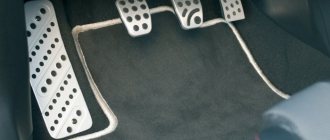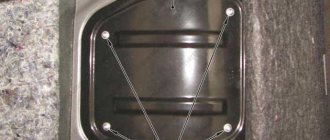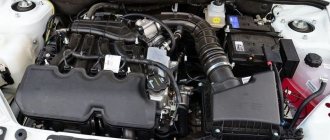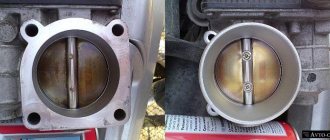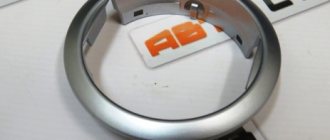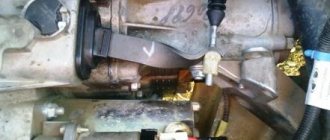From time to time, every car owner is faced with a situation where the vehicle begins to jerk when starting to move when pressing the gas pedal or driving at low speeds. This behavior of the car is often caused by not too serious disturbances in the operation of the internal combustion engine and other systems. However, they need to be diagnosed and eliminated as soon as possible. Otherwise, they can lead to a complex breakdown, which will take a lot of time and money to fix.
When can a car “jerking” appear and what are the causes of the phenomenon?
In the vast majority of cases, the symptom of unstable driving can be diagnosed in the following situations:
• While the vehicle is starting to move (pushing away).
• During slow driving at low engine speeds.
• If necessary, accelerate suddenly while driving on the road.
• While the power unit is operating at high speeds.
In addition, the described behavior of the vehicle may also occur in other operating modes. The reason for this may be malfunctions of the following systems and components of the machine:
1. System for supplying the fuel mixture to the combustion chamber.
2. Ignition system.
3. Incorrect operation of the transmission.
4. Malfunctions in the operation of the car's electronic engine control unit.
How to troubleshoot?
Let's take a closer look at the main and auxiliary systems of the car, which can cause the vehicle to “jerk” while driving. We will also focus on how to eliminate diagnosed problems.
Fuel mixture supply system
Quite often, the cause of unusual behavior of a car while driving is improper operation of the fuel supply system to the engine or the injection system of the air-fuel mixture into the combustion chamber. In other words, the internal combustion engine cannot obtain the required amount of gasoline or diesel fuel. As a result, there is not enough torque from the shaft to transfer mechanical force to the suspension, and you end up with a dip in power.
To get rid of troubles, you need to:
• Check the operation of the throttle assembly.
• Test the functionality of the idle speed sensors.
• Check the correct position of the throttle valves.
• Check the functionality of the mass air flow sensor.
In most cases, the defect is found in the injectors, which are responsible for injecting the fuel mixture. Less commonly, an uneven ride is associated with the air passages that connect the injector and the air filter. Depressurization is possible, which leads to loss of pressure.
The problem found can be corrected by replacing damaged parts. You can do this yourself, but it is better to seek help from service center specialists. After carrying out the work, it is important to additionally check the tightness of connections along all fuel and air supply lines.
If your car is equipped with a carburetor, you need to check the idle air valve and also make sure that the body of the device itself does not contain cracks, chips or other defects.
Ignition system
The next most common cause of a car “jerking” is a breakdown in the ignition system. This leads to the fact that the fuel mixture in the cylinders ignites at the wrong time. In addition, this may also occur due to the fact that low voltage current is supplied to the spark plugs. And the resulting spark is not enough for ignition to occur.
To diagnose faults you should check:
• Serviceability of spark plugs installed in the engine.
• Integrity of high-voltage wires going to the spark plugs.
• The performance of sensors that monitor the position of the camshaft and crankshaft.
Often, the car may jerk due to physical wear of the spark plugs or because the spark plug gap does not meet the required parameters.
Transmission
“Jerking” of the car can also occur due to the fact that the transmission elements are not operated in accordance with the technical regulations. This happens, for example, if the transmission fluid in the gearbox (especially automatic) has not been changed. And when the car’s mileage is 150-200 thousand km, it is necessary to repair the automatic transmission, otherwise the car will drive with slight jolts all the time.
It is better to carry out maintenance of such a complex unit as a gearbox only in a specialized center. You can take on work yourself only if you know exactly what needs to be done and how.
Riding style
Speaking about why the car jerks when starting from a stop, we need to start with the obvious. The very first and most obvious reason is a harsh clutch. If you start, add gas and suddenly release the clutch pedal, the car will definitely jerk. Therefore, first of all, you need to try to change your driving style. At a minimum, when starting off, you need to release the clutch pedal very slowly and add a little more gas. However, you shouldn't press the gas pedal too hard.
However, if with an automatic transmission the car jerks when starting, then you won’t be able to change your driving style here, because there is simply no clutch pedal. But even with a manual transmission, the problem may be different. If the car still jerks even when starting smoothly, the problem is clearly not a sudden grip of the clutch discs.
This is interesting: Car tire markings (decoding) Lada Granta
How to prevent this?
The following tips are a little banal, but effective. At a minimum, you need to fill your car with high-quality gasoline with the correct octane number. The instructions for the car must indicate what fuel should be poured into the tank.
This also applies to oil. It is necessary to use only the lubricant recommended by the manufacturer. Taking into account the presence of counterfeit oils on the market and low quality fuel, it is necessary to change oils even more often than the car manufacturer recommends. At a minimum, after 8-9 thousand kilometers the lubricant must be replaced. This will extend the life of the motor.
External and internal CV joints
If some suspension parts are poorly secured, then when driving (especially during a sharp start), they can cause the car to jerk. First of all, you need to check the inner and outer CV joints. The inner CV joint transmits rotational energy from the gearbox to the axle shafts and then to the wheels. This element is quite important, and if problems arise with it, it must be changed. This can be done at any service station. Features of failure of the inner CV joint are as follows:
- When destroyed, the inner CV joint becomes loose and can turn when transmitting forces, especially at the start.
- On a straight road without the smallest potholes, the inner CV joint can knock. In this case, it will seem that a dull knock is coming from the wheels.
- Outer CV joints may crunch when turning. If destroyed, they can also cause the car to jerk when starting off.
- Usually, internal CV joints simply wear out and because of this they fail. However, rarely the gearbox can cause a breakdown of this unit. This happens in cases where there is something wrong with the box itself.
- Outer CV joints can break due to impacts or careless driving on a bad road.
If your VAZ car jerks when starting from a stop, then first of all you need to check the CV joints. Often on forums when discussing a similar problem, users point to this particular node. Considering the prevalence of these cars and the cheapness of spare parts, repairing this element is unlikely to be expensive. It is worth noting that a similar problem occurs on the VAZ-2114 car. When starting off, the car jerks, but after replacing the CV joint (“grenade”), the problem disappears.
You will be very lucky if the problem turns out to be in the car's CV joints. These are inexpensive items that are easy to replace. It is much worse if a fault is discovered in the gearbox.
Transmission problem
The gearbox may well be the reason why the car jerks when starting off. However, there should also be other signs of a gearbox malfunction: difficulty shifting all or any one gear, a strange sound from this unit, etc. If this happens on the “mechanics”, then the problem is not so bad. In this case, the box itself can be repaired, and due to the simplicity of its design, repairs will not be so expensive. But if this problem is in the automatic transmission, then this is already serious.
Do they repair gearboxes?
In any case, you will have to go to a service station, where they will examine the car and issue a conclusion. If the automation fails, repairs will be quite expensive. However, if any gear from the mechanism breaks down, the box, in principle, can be disassembled and a separate element replaced, but this is also a rather painstaking and complex procedure, and it costs money.
Note that quite often service stations do not undertake to repair automatic transmissions at all. Often they are simply replaced, but there are craftsmen who agree to restore these units, which allows the owner to save money.
Other section materials
| The engine does not develop full power |
| Popping sounds in the intake pipe |
| Silenced shots |
| Increased fuel consumption |
| Increased oil consumption |
| Engine knock |
| The engine gets very hot |
| The electric fan of the engine cooling system is constantly running |
| The engine takes a long time to warm up to operating temperature |
| Drop in coolant level in the expansion tank |
| Extraneous noises and knocks in the engine |
| Strong engine vibration |
| Increased content of harmful substances in exhaust gases |
| The "Check" engine management system malfunction indicator lights up when the engine is running. |
| Engine compression test |
| Checking the ignition coil and its circuits |
| Insufficient oil pressure |
| Checking high voltage wires |
| Checking the pressure in the engine power supply system |
| The clutch is slipping |
| Clutch leads |
| Jerking when starting off |
| Rattling, knocking noise when engaging clutch |
| Increased noise when engaging the clutch |
| Gearbox noise |
| Gears are difficult to engage |
| Gears turn on spontaneously |
| Noise, crackling, squealing of gears when the gear is engaged |
| Final drive noise |
| Oil leak |
| Knock when starting |
| Noise when driving on a smooth highway |
| Knock when driving over bumps |
| Knocking, squeaking noises when the suspension operates |
| There are traces of shock-absorbing fluid on the telescopic strut |
| There are traces of grease on the drive joint cover (shaft) |
| Knocking, clicking noises when turning |
| Vibration when driving |
| Deviation from straight-line motion |
| Rapid tire tread wear |
| Uneven tire tread wear |
| Increased free play of the steering wheel |
| The steering wheel turns hard |
| Creaking, squealing when braking |
| Vibration when braking |
| Pull or skid when braking |
| Increased brake pedal travel |
| The brake pedal travel is normal, but the car does not brake well. |
| Incomplete release of all wheels |
| Braking one of the wheels |
Information letter No. 5 - dated 01/23/17
When owners of LADA cars of the KALINA, GRANTA, PRIORA, VESTA families, equipped with a 1.6 liter engine and gearboxes 2180/2181/2182, complain about “Vibrations, jerking when starting the car,” carry out diagnostics according to the attached methodology, Appendix 1.
If you need to replace the clutch kit:
- If the vehicle is equipped with clutch driven disc 21703-1601130-30, in the absence of violation of operating rules, replace the clutch kit under warranty with: pressure plate 21703-1601085-30, driven disc 21703-1601130-31;
- If the vehicle is equipped with a driven clutch disc 21703-1601130-31 (standard installed only on LADA VESTA GFL120 (KP 21827) vehicles) or a driven clutch disc 21703-1601130-32 (standard installed only on LADA VESTA vehicles GFL110 (KP 21807)) it is necessary to draw up a CLO with a description of the work performed and act in accordance with the recommendations received in response to the CLO.
New Lada: LADA Priora maintenance calculator – AutoHERMES
Fill out an AGO for the work carried out with a description of the reasons for the non-compliance and using the defect code, 1601130-051-001 “Vibration, jerking when starting a car with AMT”, with an attachment of a photo of the error codes or 0 “Vibration of the car when starting off”, depending on vehicle configuration, defective part 1601130, labor intensity position in accordance with the current collection of labor intensity.
This is interesting: Removing and installing the engine (8V) Lada Largus
Steering gear
If the steering mechanism is faulty, a similar problem can also occur. If the steering rack has any malfunction, it can create jerks when starting. In this case, the worn parts of the rack are simply replaced, and the problem disappears.
Also, the steering rack tips may have strong play. As a result, during a sharp start or braking, or increase in speed, so-called steering wheel wobble may occur. Bent tie rods result in a sharp jerk of the steering wheel to one side when starting off. This problem requires a quick solution.
Other elements of the steering system, including bushings and silent blocks, can cause the car to knock and jerk when driving. All this applies to the steering mechanism - it can be the reason why, for example, a GAZelle car jerks when starting off. But GAZelle is not the only brand where such breakdowns occur.
Note that problems with the steering mechanism are easier to solve than problems with the automatic transmission. However, the steering mechanism requires urgent repair for the safety of the driver and passengers.
Fuel system
If the fuel mixture is supplied to the combustion chambers of the engine in the wrong amount, jerking may occur when driving. This can happen if the car owner fills the tank with poor quality fuel or gasoline that the car is not designed for. For example, if a Euro-4 or Euro-5 engine is supplied with fuel with a high sulfur content (92 gasoline), it will wear out quickly. Some injectors may also become clogged, causing the wrong amount of fuel to be delivered. This can lead to jerking at start, but the “symptoms” can be different: loss of power, detonation, increased gas consumption.
Checking VAZ-2107
Now let's take a closer look at how to identify the cause of such a malfunction on different car models.
The first will be the carburetor VAZ-2107; there are plenty of cases when the car suddenly starts to jerk while driving.
As already mentioned, you need to start checking with the fuel system:
- First you need to inspect all pipes of the system for cracks;
- Open the tank. It happens that in the summer the lid fits very tightly to the neck, blocking the access of air to the tank. When moving, the pump works and creates a vacuum in the tank, due to which the same pump is then unable to “pull” fuel. It seems like a small thing, but this also happens;
- Inspect the fuel filter located in the pipes leading to the fuel pump. These filters are transparent and easy to visually evaluate;
- You can also check the fuel pump without removing it. It is necessary to disconnect the pipeline coming from the pump from the carburetor and lower its end into some container. Then manually pump the pump into action and evaluate how it pumps fuel - it should supply it in even portions;
- While the fuel pipe is disconnected from the carburetor, unscrew the fitting on which the fuel line fits and remove the small mesh filter, clean it and reinstall it;
- Next comes the carburetor. It is advisable to remove it from the car, rinse it thoroughly, and inspect the accelerator pump membrane.
New Lada: Lada Granta 1.6 MT Standard (12.2011 - 12.2014)
If actions with the fuel system did not help, we proceed to checking the ignition system.
- We unscrew the spark plugs, check their functionality, and replace them if necessary;
- We check the system wiring for breakdown. This can be done this way - in the dark or in a closed garage (the main thing is that it is dark), open the hood and start the engine. If there are voltage losses on the wiring, they will be immediately noticeable by the sparks that form. Next, we replace the wiring that “breaks through” and check the wire connections;
- Next, we check the distributor, there should be no signs of critical wear, it should be dry under the cover. Be sure to inspect the centrifugal regulator, and also check the vacuum regulator. You should check whether there is a vacuum in the pipe leading to it.
- Then the Hall sensor, coil and switch will be checked for functionality. You can do this yourself if you have the necessary equipment at hand, but you need to know how to check them. But you can contact an auto electrician.
- It is also important not to forget to check the correctness.
This is in general and all the features of identifying the cause of uneven running on the VAZ-2107.
What causes the car to jerk when running at low speeds?
Since the car begins to twitch when reaching even low speeds, it will not be possible to immediately identify one specific problem. Problems may be hidden:
- In the engine fuel mixture supply system;
- In the vehicle ignition system;
- At the checkpoint;
- In the distributor design;
- Includes fuel filters;
- In the sparking system;
- In the control unit of the vehicle's on-board computer.
Let's go through the faults in each of the listed systems in detail.
Tip: When detecting a “jerking” behavior in the vehicle, the brakes may also squeak when braking. These 2 problems can be either interrelated or indicate completely different breakdowns.
Checking the engine fuel mixture supply system
Often the reason that the car jerks at low speeds is due to a malfunction of the power system. When the car starts to move, the cylinders simply cannot receive the required amount of fuel mixture, as a result of which the car is unable to transfer the required amount of power to the chassis for smooth driving and smooth commissioning of the transmission. As a result of increased pressure and transmission resistance, uneven running of the machine appears.
To solve this problem, it is recommended that you first pay attention to checking the throttle body. It also wouldn’t hurt to test and diagnose the performance of the sensors installed in the system for determining idle speed indicators. Do not forget to check the serviceability of the throttle valve position and the mass air flow sensor.
Throttle body
During diagnostics, most often a breakdown is found in the injectors responsible for uniform injection of the fuel mixture. In rare cases, engine jerking problems may be related to the air ducts that connect the injector receiver to the air filter structure. Here the problem lies in depressurization of connections and loss of pressure.
The solution to the problem is to replace all faulty components yourself or with the help of car service specialists. After repair, it is recommended to ensure that all connections are in good working order and that there is no loss of pressure in the fuel line system that is connected to the fuel pump itself.
If a power unit with a carburetor system was installed in the engine compartment of your vehicle, then you need to check the idle valve and the absence of damage directly to the carburetor.
fuel mixture
Checking the car's ignition system
Sometimes the car starts to jerk while driving at low speeds as a result of a breakdown in the ignition system. Basically, the problem will be caused due to untimely ignition of the fuel mixture and air flow. In rare cases, the malfunction may be hidden in the receipt of low voltage from the spark plugs. The spark voltage simply will not be enough to ignite the fuel mixture in a timely manner. Also, when diagnosing the ignition system, check:
- Performance of ignition coils;
- Serviceability of the spark plug set;
- No tears in high-voltage wires;
- There are no problems in the ignition distributor-interruptor (in simple terms - in the distributor);
- Correctness of values coming from a set of sensors responsible for the position of the camshaft and crankshaft;
- The performance of the switch located inside the entire structure.
Often, the car may jerk due to the long use of a set of spark plugs. There is often a situation where problems are caused by spark plug gaps not meeting established standards.
Advice: if the ignition module on a VAZ-2112 is faulty, the crankshaft position sensor will be damaged and it will not be possible to start the car’s engine at all. This problem can only be solved after a thorough check and subsequent repair of the knock sensor.
ignition coil
Checking the car gearbox
Jerking of a vehicle engine often occurs due to improper operation of the engine and infrequent maintenance of automatic transmissions. If the total mileage of your car is 100-200 thousand km, then even with a seemingly serviceable gearbox, the car will move with some jerks.
As a result of frequent jerking of the engine, the oil in the box foams, causing the amount of solution to be either too small or too large. Repairing a gearbox takes a little time. In a car service center, in just a couple of hours they will remove the box and restore its operation.
Transmission
Problems with the accelerator
At the moment when the driver sharply presses the gas pedal, a rapid increase in engine speed occurs, which, in turn, can lead to ineffective operation of the vacuum ignition angle regulators. As a result, at low speeds the distributor will sink, and the car will begin to move jerkily.
Since, with the gradual combustion of gasoline, the driver begins to increase engine speed, the engine must ignite and let in the fuel and air mixture even faster. If there is a problem with the vacuum regulators, the car will not be able to quickly increase speed, which will cause problems with opening the throttle valve. Without the simultaneous opening of the damper and air supply, gasoline will not be able to burn in time, which can ultimately lead to damage to the bearing, which is responsible for the ignition timing.
To solve the problem, the vacuum regulators are first diagnosed. Here you can independently remove all the hose and pipes, having previously tightly covered them with your hands. When the engine is running, you will hear the retracting effect of the regulators working. If a vacuum does not form when the air mixture is supplied, it means that the seal is broken precisely because of the damper. You should replace it and assemble all components in the reverse order.
Engine
As sad as it is to admit, a problem with the engine also occurs when such problems occur in the operation of the car. If there is really something wrong with the engine, its speed should jump during sudden jerks. The engine itself can live its own life and respond weakly to the gas pedal.
What could cause the engine to run like this:
- Wear of friction pairs, which requires major repairs. This requires a lot of investment.
- Crankshaft wear. In this case, the car should not only start to move jerkily, but also make noise and knock from the engine.
- Engine coking. In this case, decarbonization will be required, which can be done at a service station.
Note that engine-related problems are the most unpleasant and most often require a large investment.
"Brains" of the car
A special program decides in what proportion to mix fuel with air and feed it into the combustion chambers. If the program makes an error, then the engine will receive a mixture with an incorrect air/gasoline ratio, which can also cause the car to jerk when starting off. An oversaturated or undersaturated mixture may be fed into the combustion chambers, then a batch of normal mixture may enter the system, after which improper mixing occurs again - all of which can easily cause the car to jerk, both when starting and when driving at speed. This may also be accompanied by popping noises from the exhaust pipe or lack of engine response to the gas pedal.
Diesel engines
If there are signs of uneven acceleration, the worst failure for diesel engines is turbine failure, since both the part itself and its replacement are expensive. Typically, symptoms of compressor failure are not sudden. And the later they are identified and eliminated, the more expensive the repairs will be. Therefore, it is important to remember that turbocharger defects must be repaired in a timely manner. Main signs of impending failure:
- turbine whistle;
- blue or black smoke from the chimney;
- loss of power during uniform movement or acceleration.
It is also not uncommon for the turbine pressure sensor to fail, which is why air compression may not meet the engine’s needs. This is an inexpensive part that can be replaced using an amateur tool.
More common causes of jerky driving are leaks in the vacuum hoses. These black, inconspicuous tubes have a big impact on the performance of the diesel engine. If damage or ruptures can be detected, restoring the seal yourself will not be difficult.
It can be said that most causes of jerking in both diesel and gasoline cars can be eliminated and even prevented by regular maintenance. Often this is simply the result of dirt or worn parts. Other causes occur less frequently and are best eliminated in specialized workshops.
Causes of malfunction
General view of the engine
As in any car, in the Lada Kalina, jerking at low speeds is the first sign of a malfunction in one of the systems. Let's look at where the main problems arise:
- The fuel system and its components can cause the problem.
- The ignition system is associated with the fact that the car jerks at low speeds.
- Another reason could be the gearbox.
To more accurately determine the causes of the malfunction, it is worth considering each system and component separately.
Fuel system
The car jerks at low speeds - this may be due to the fact that the engine does not receive enough fuel mixture.
The problem may lie in the fuel system. In this case, you will have to examine several elements that are part of it.
Fuel rail and fuel injectors
Let's look at finding the problem step by step:
- The first place to look for a problem is the fuel rail and injectors . It is the poor condition of this unit that can cause the car to jerk when accelerating.
- The fuel pump, filter and lines can cause the driver to feel slight jolts at low speeds. For diagnostics, you will need to remove the fuel pump from the gas tank housing.
What's the result?
As you can see, at the initial stage of diagnosis, if the engine twitches at idle, you should start with the simplest:
- check spark plugs and high-voltage wires;
- assess the condition of the air and fuel filter;
- if the car has a carburetor, clean and adjust the carburetor;
- on the injector, check and wash the nozzles;
- perform computer diagnostics of the engine;
If the diesel engine jerks at idle, then problems with the injection pump should also be added to the general list of possible problems. The pump has many moving elements, damage to which or clogging can also lead to jerking or obvious tripping in the cylinders.
Why might the engine vibrate at idle? Causes of malfunction, diagnostics. Tips and recommendations for reducing engine vibration levels.
In idle mode and at low speeds, the engine shakes: possible reasons for the unstable operation of the power unit. Self-diagnosis methods.
For what reasons may misfire of the fuel-air mixture occur in one or more cylinders? Fault diagnosis, recommendations.
Signs of a non-working cylinder (tribbing and vibration) of a diesel engine. Troubleshooting: compression, diesel injectors, glow plugs, injection pump and others.
Causes of vibration and unstable operation of a diesel engine in idle mode. Possible causes and fault diagnosis.
Engine trouble: symptoms. Why does tripping occur and how to find the reason why the motor starts to trip. Checking power, ignition, compression, etc.
Situations when a car starts to jerk for no reason are common. In some cases the problem is resolved quickly, but in others it cannot be resolved for a long time.
The whole problem here lies in the reasons for this phenomenon, which are not so easy to identify as it seems at first glance.
But we will try to help you with this.
Let's try to figure out in detail what can cause the car to jerk while moving. But to do this, you first need to understand how everything happens.
Diagnostic technique
Methodology for diagnosing a car and eliminating the defect notes “Vibration, jerking when starting the car”:
1. Test drive to confirm the defect. Is the defect confirmed?
- YES - go to step 2:
- NO - no repair work is required.
2. Checking for the presence of fault codes in the ECM and KURKP. Are there any fault codes?
- YES - eliminate the causes of their occurrence in accordance with the relevant technical specifications, and then proceed to step 1;
- NO - go to step 3.
3. Are there any comments on the stability of the engine at idle and low speeds?
- YES - eliminate the comment and go to step 1;
- NO - go to step 4.
4. Are there any leaks of working fluids (oil, coolant) in the gearbox area? Was there a risk of getting caught in the clutch?
- YES - eliminate the causes of their occurrence and go to step 5;
- NO - go to step 6.
5. Remove the clutch. Are there any signs of oil and/or coolant on the clutch friction surfaces?
- YES - replace the clutch kit and wipe the flywheel with acetone/degreaser to remove oil and/or coolant;
- NO - go to step 6.
6. Are there any damages to the power unit supports?
- YES - eliminate the comments and go to step 1;
- NO - go to step 7.
7. Are the tightening torques of the bolts securing the power unit supports adequate?
- YES - go to step 8;
- NO - reach the required values and go to step 1.
8. Are the tightening torques of the bolts of the belt securing the gearbox to the engine maintained?
- YES - if there are no violations of the operating rules, replace the clutch kit;
- NO - reach the required values and go to step 1.
Note: the most obvious starting mode in which vibration appears is smooth starting on small slopes. At the same time, when starting, you must not allow the engine speed to drop below idle speed.
Let us remind you that you can determine which transmission is installed on a Lada Vesta car by the values from the fourth digit of the VIN code (GFL11 - VAZ manual transmission; GFL12 - AMT; GFL13 - Renault manual transmission).
New Lada: Subtleties of choosing and replacing spark plugs for 16-valve Priora engines
By the way, we have already described how the clutch is replaced under warranty, as well as other AvtoVAZ regulations.
Keywords: Lada Vesta clutch | clutch Lada Kalina | Lada Granta clutch | Lada Priora clutch | gearbox Lada Vesta | gearbox Lada Kalina | gearbox Lada Granta | gearbox Lada Priora | AvtoVAZ order
7
Share of sales of cars with automatic transmission as of mid-2020
- Reasons why Lada Priora wipers do not work
- Operating instructions Lada Largus
- Review and reviews of the frill (windshield cover) for Lada Largus
Why does the car jerk when starting off?
If the car starts to jerk while starting from a stop, the reason is usually due to a malfunction of the clutch or CV joints. In such cases, it is imperative to carry out diagnostics in order to immediately determine the breakdown and begin to eliminate it.
The main thing is not to panic, you need to make sure that before you start driving, the engine is warmed up to operating temperature, there are no problems with the ignition and the fuel supply system. If everything is normal here, then we need to further look for the cause.
Driving style
Inexperienced drivers often abruptly release the clutch pedal, causing the car to start jerking away. There are no malfunctions, you just need to change your driving style, learn to smoothly release the clutch and add gas at the same time.
It is necessary to determine the moment of clutch actuation on the car. To do this, start off without adding gas and smoothly release the clutch. Having determined in what position the clutch begins to engage, you can move away smoothly. On a car with an automatic transmission there is no clutch pedal. In order for such a car to move without jerking, the gas pedal must be pressed smoothly.
Problem with CV joints
In front-wheel drive cars, the force from the gearbox is transmitted to the wheels using internal and external CV joints. If these parts partially fail, the car will jerk when moving away.
Signs of CV joint failure:
- backlash;
- knocking while driving;
- crunching when turning.
Replacing CV joints can be done at a service station or independently. These are relatively inexpensive parts that require little time to replace. Having an inspection hole and a set of keys, you can replace the CV joints with your own hands.
Procedure for replacing the CV joint:
- Removing the wheel from the side where the CV joints will be replaced.
- Loosening the hub nut.
- Unscrewing the bolts that secure the outer CV joint to the main drive shaft.
- Removing the axle shaft. It is removed along with the inner and outer CV joints.
Clutch faults
Very often, problems associated with car jerking at the start occur when the clutch breaks down.
Main clutch malfunctions:
- wear or damage to the driven disk, repair consists of replacing it;
- jamming of the disc hub on the gearbox input shaft. Clean the slots from dirt and remove burrs. If the damage is large, you will have to replace the disk or shaft;
- wear of the linings or loosening of their fixation is eliminated by installing a new driven disk;
- weakening or breakage of springs, window wear is eliminated by replacing the disk;
- Seizure on the flywheel or pressure plate. You will have to change the flywheel or clutch basket;
- loss of elasticity by the spring plates located on the driven disk. Eliminated by replacing the driven disk.
Replacement of the clutch driven disc is carried out in the inspection pit. You can raise the front of the car using jacks or a winch.
Work order:
- Preparatory work. Depending on the design of the car, you will need to remove the starter, driveshaft, resonator, exhaust manifold and other parts.
- Removing the gearbox allows access to the clutch.
- Removing the clutch basket cover. After this, all parts are removed from the flywheel. A new driven disk is installed and the mechanism is assembled.
Messages 15
1 Topic by Alternative 2017-03-24 17:58:52
- Alternative
- Participant
- Inactive
- Registration: 2016-04-06
- Messages: 99 Thanks : 14
- Car: VAZ 2110
Topic: Jerks (shakes) when pulling away with clutch
Good afternoon everyone. There was a problem when starting off with the clutch, the car twitched and shook. A couple of weeks ago, I changed the clutch, pressure plate and release bearing, but the problem remained. The old parts were not very worn out, but I replaced them anyway. What else could be the reason for all this? Now it mostly shakes, starts off well and smoothly with gas.
2 Reply from “Robotron” 2017-03-24 23:23:27
- "Robotron"
- Experienced
- Inactive
- Registration: 2015-11-22
- Messages: 292 Thanks : 81
- Car: VAZ – I spin it myself
Re: Jerks (shakes) when starting with the clutch
The cause may be a worn out flywheel. When replacing the clutch, what condition was the flywheel in?
Now it mostly shakes, starts off well and smoothly with gas.
– at what speed? Measure the pressure in the fuel rail.
3 Reply from Alternative 2017-03-25 10:27:44
- Alternative
- Participant
- Inactive
- Registration: 2016-04-06
- Messages: 99 Thanks : 14
- Car: VAZ 2110
Re: Jerks (shakes) when starting with the clutch
The cause may be a worn out flywheel. When replacing the clutch, what condition was the flywheel in?
Now it mostly shakes, starts off well and smoothly with gas.
– at what speed? Measure the pressure in the fuel rail.
There is little wear on the flywheel, you can still drive. Shakes when starting, at xx (840). How can pressure affect it? The engine runs fine at idle.
4 Reply from “Robotron” 2017-03-25 12:31:41
- "Robotron"
- Experienced
- Inactive
- Registration: 2015-11-22
- Messages: 292 Thanks : 81
- Car: VAZ – I spin it myself
Re: Jerks (shakes) when starting with the clutch
It looks like your engine is not pulling, when I release the clutch pedal without touching the gas pedal, the car starts and goes 6 km/h at idle
5 Reply from Alternative 2017-03-25 12:55:26
- Alternative
- Participant
- Inactive
- Registration: 2016-04-06
- Messages: 99 Thanks : 14
- Car: VAZ 2110
Re: Jerks (shakes) when starting with the clutch
It looks like your engine is not pulling, when I release the clutch pedal without touching the gas pedal, the car starts and goes 6 km/h at idle
I have the same thing, but it shakes when I start moving.
6 Reply from OlegD 2017-03-25 13:09:58
- OlegD
- Connoisseur
- Inactive
- From: Moscow
- Registration: 2014-01-15
- Messages: 511 Thanks : 115
- Car: 21114, door 21124 1.6 l., 2007 onwards
Re: Jerks (shakes) when starting with the clutch
Does it jerk only when releasing the clutch? Could the flywheel have moved?
7 Reply from Alternative 2017-03-25 13:38:02
- Alternative
- Participant
- Inactive
- Registration: 2016-04-06
- Messages: 99 Thanks : 14
- Car: VAZ 2110
Re: Jerks (shakes) when starting with the clutch
Does it jerk only when releasing the clutch? Could the flywheel have moved?
Yes, it is in the process that it begins. As soon as the slightest movement appears, shaking begins. Before replacing the clutch it was strong, now it is a little less. We looked at the flywheel and everything is fine with it. Maybe the problem is not in the flywheel?
8 Reply from OlegD 2017-03-25 14:58:12
- OlegD
- Connoisseur
- Inactive
- From: Moscow
- Registration: 2014-01-15
- Messages: 511 Thanks : 115
- Car: 21114, door 21124 1.6 l., 2007 onwards
Re: Jerks (shakes) when starting with the clutch
Maybe, but unlikely. I have an improvement proposal: maybe we should forget about this? I was also recently told that when I try to start using the clutch, something is wrong with me. I didn’t even understand what exactly, because I always start with the gas. Or is it very annoying?
9 Reply from Alternative 2017-03-25 15:15:23 (2017-03-25 16:19:00 edited by Alternative)
- Alternative
- Participant
- Inactive
- Registration: 2016-04-06
- Messages: 99 Thanks : 14
- Car: VAZ 2110
Re: Jerks (shakes) when starting with the clutch
Maybe, but unlikely. I have an improvement proposal: maybe we should forget about this? I was also recently told that when I try to start using the clutch, something is wrong with me. I didn’t even understand what exactly, because I always start with the gas. Or is it very annoying?
The offer is very good, maybe I’ll do that) It’s just that I’m not the only one who uses the car, my wife also drives it, and she often starts without gas and is afraid of stalling. I want to do everything for her comfort =) I always take off with the gas. Well, in general, this is a little annoying.
10 Reply from “Robotron” 2017-03-25 18:56:42
- "Robotron"
- Experienced
- Inactive
- Registration: 2015-11-22
- Messages: 292 Thanks : 81
- Car: VAZ – I spin it myself
Re: Jerks (shakes) when starting with the clutch
Well, I would immediately write that sometimes my wife drives (I myself saw how they start moving in a car). This makes it clearer that there is not enough torque when the car starts moving. The main reasons: low compression, dirty mass air flow sensor, low pressure in the fuel rail, dirty coarse and fine gasoline filters, dirty air filter, dirty injectors, clogged catalyst. Have you done the diagnostics recently?
11 Reply from Alternative 2017-03-25 19:09:44 (2017-03-25 19:14:58 edited by Alternative)
- Alternative
- Participant
- Inactive
- Registration: 2016-04-06
- Messages: 99 Thanks : 14
- Car: VAZ 2110
Re: Jerks (shakes) when starting with the clutch
Well, I would immediately write that sometimes my wife drives (I myself saw how they start moving in a car). This makes it clearer that there is not enough torque when the car starts moving. The main reasons: low compression, dirty mass air flow sensor, low pressure in the fuel rail, dirty coarse and fine gasoline filters, dirty air filter, dirty injectors, clogged catalyst. Have you done the diagnostics recently?
=))) I have January 7.2, there is no catalyst. I do the diagnostics myself, there are almost no deviations for my ECU, except for the advance angle, which can be 5. Basically, everything is normal. The only thing is that I haven’t measured the pressure yet and haven’t cleaned the injectors. Well, compression in 2=6 in 3=9 But how can this affect when xx is stable?
Source: xn--2111-43da1a8c.xn--p1ai

